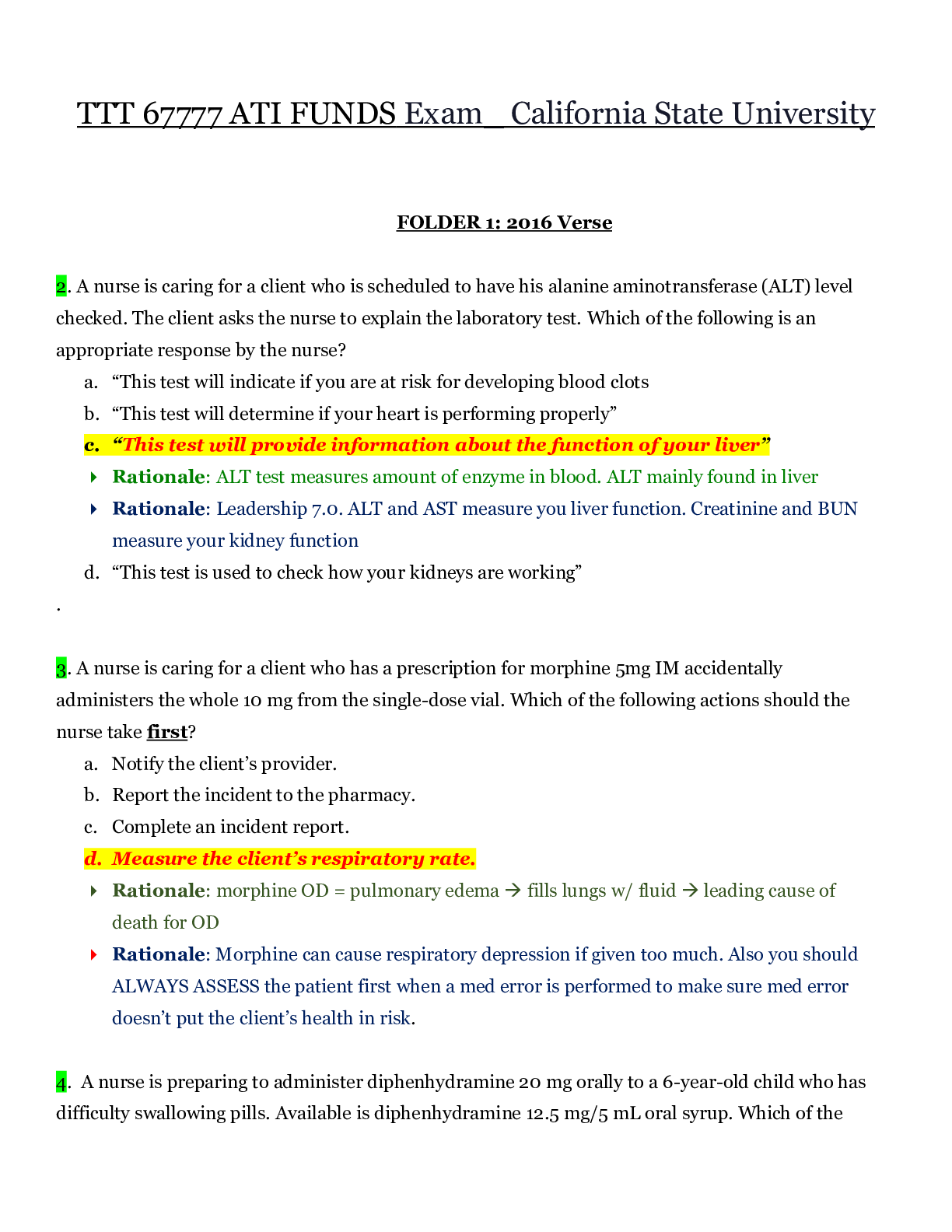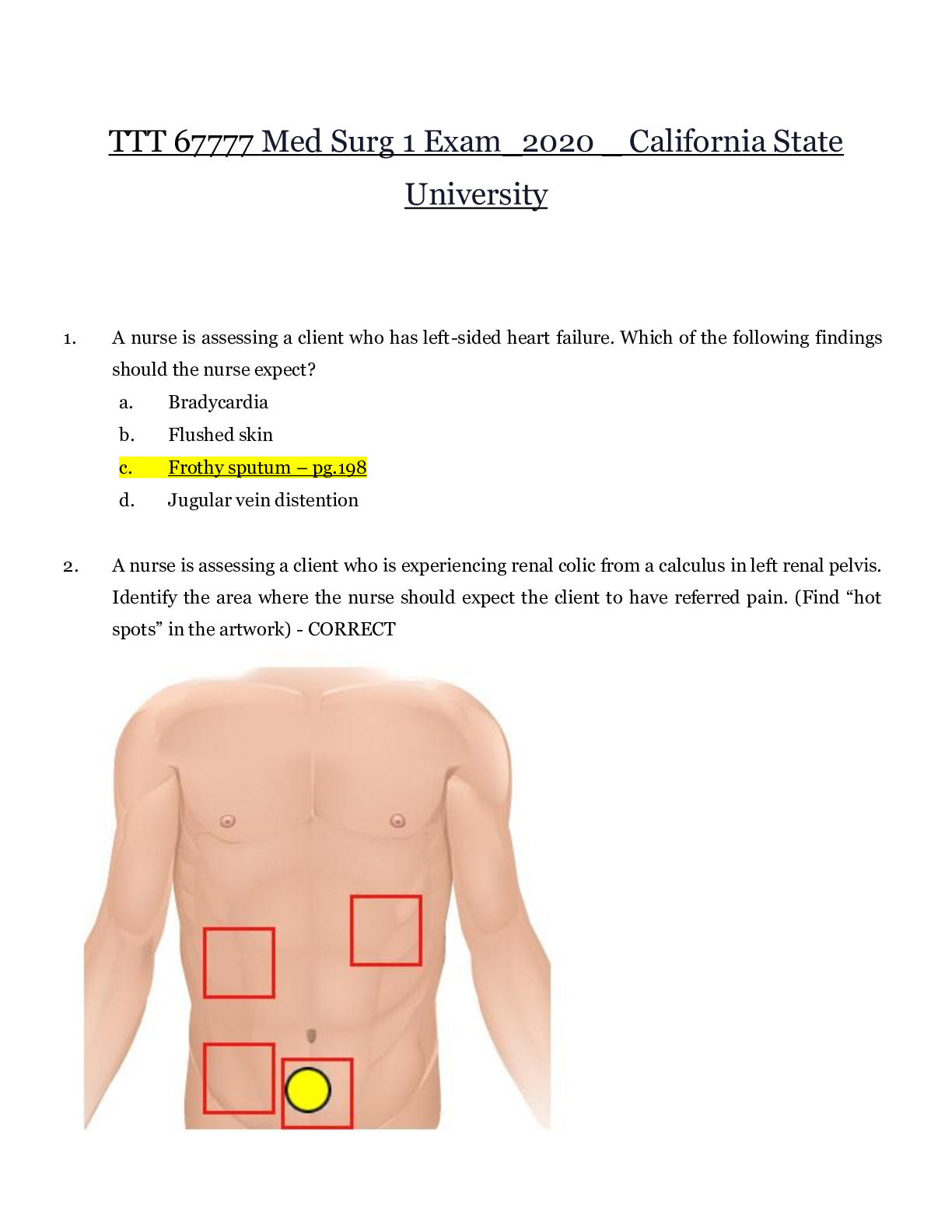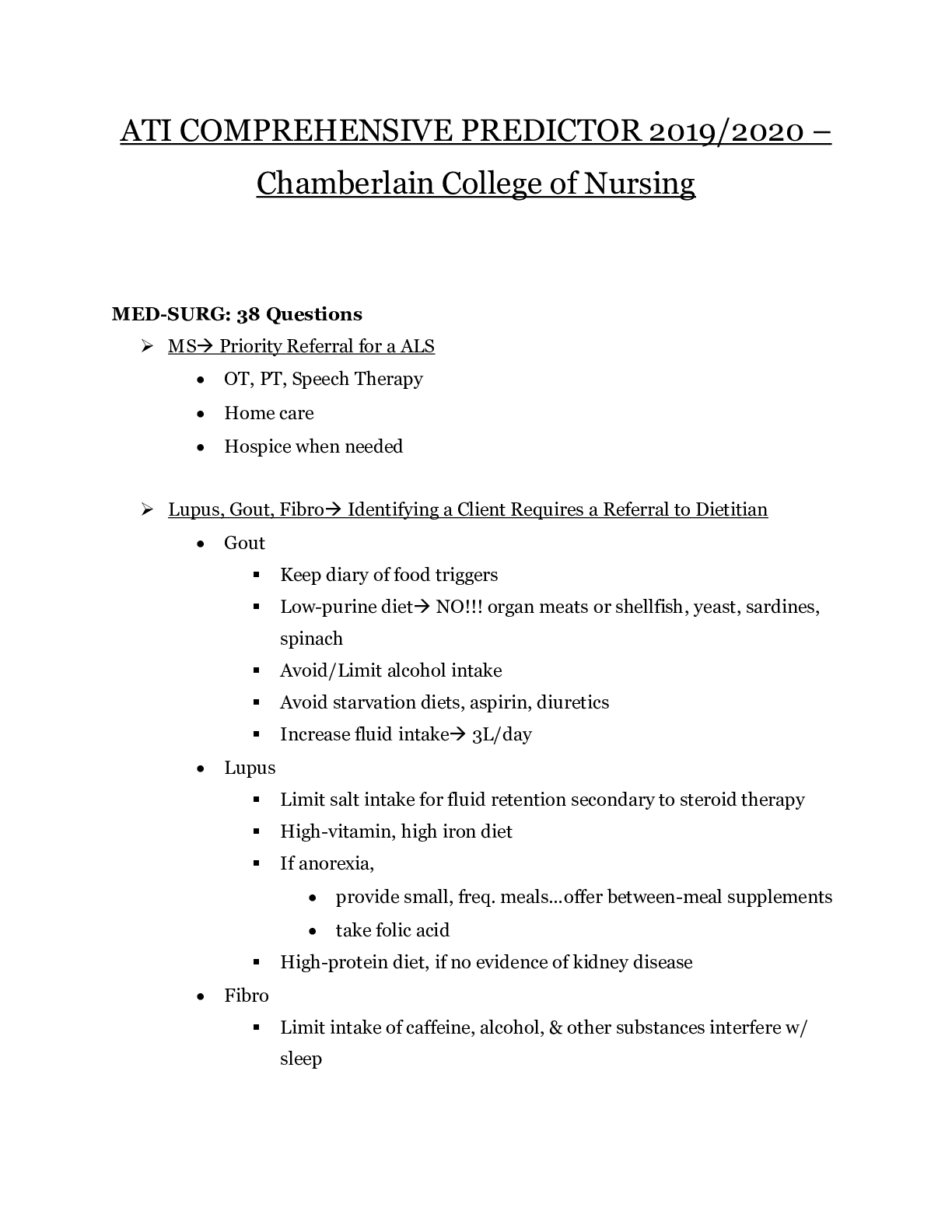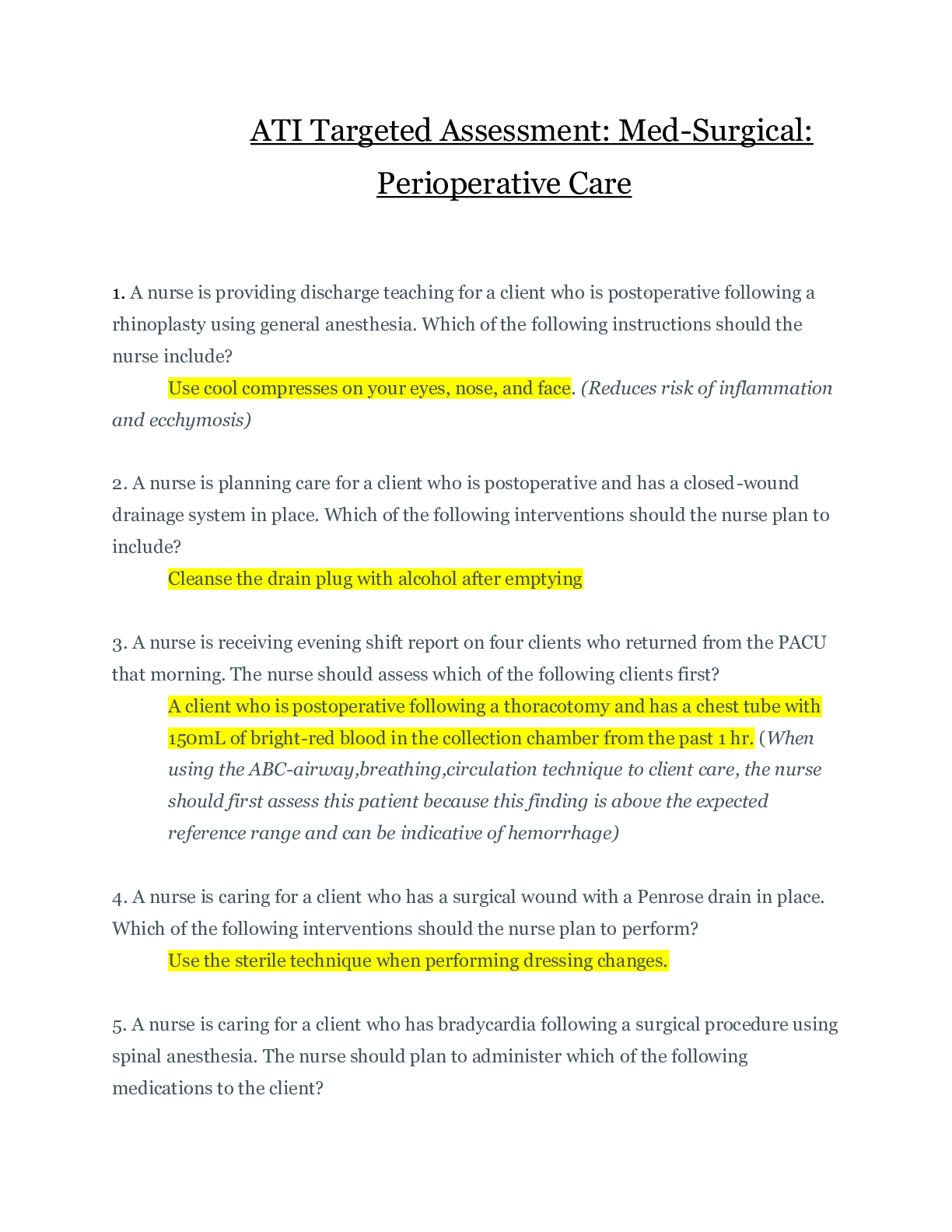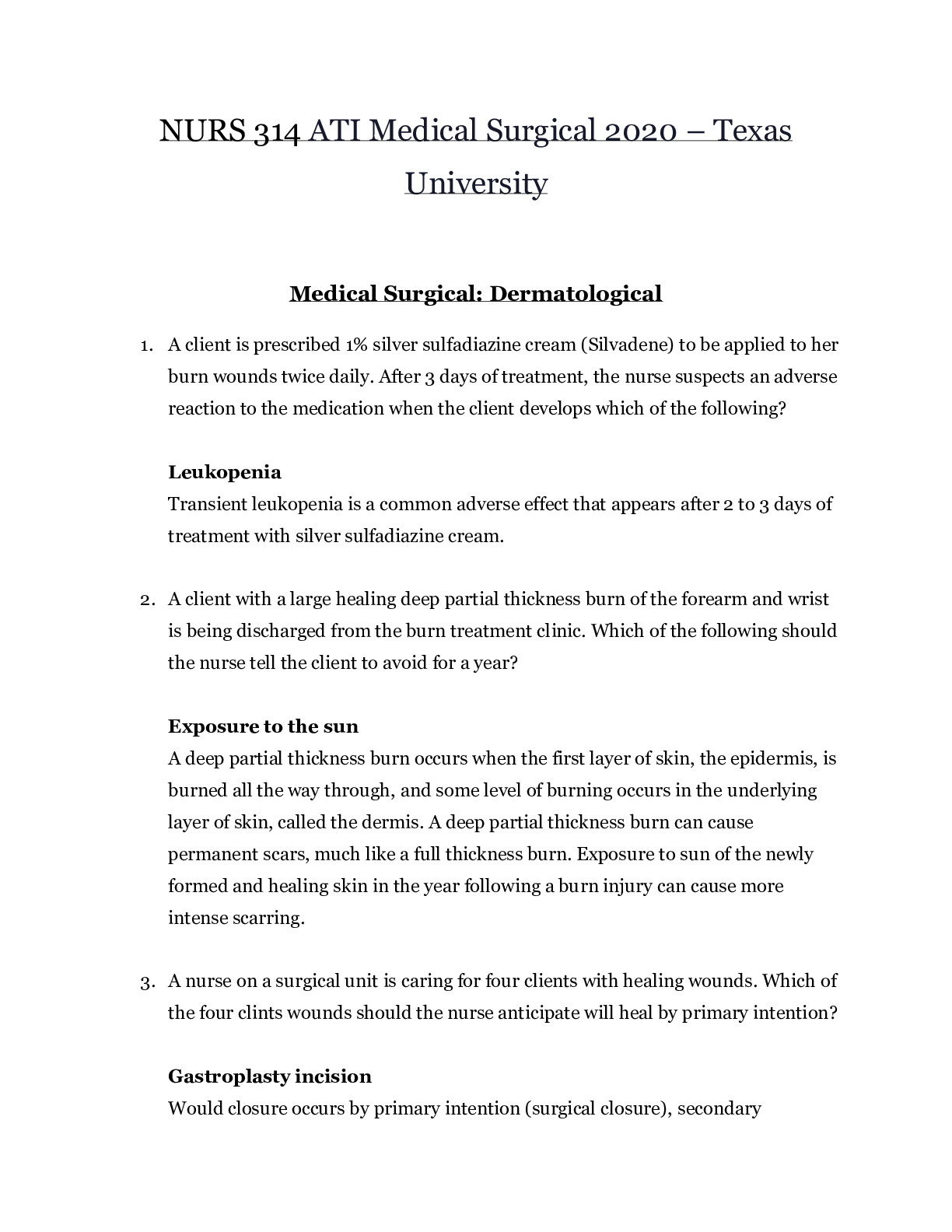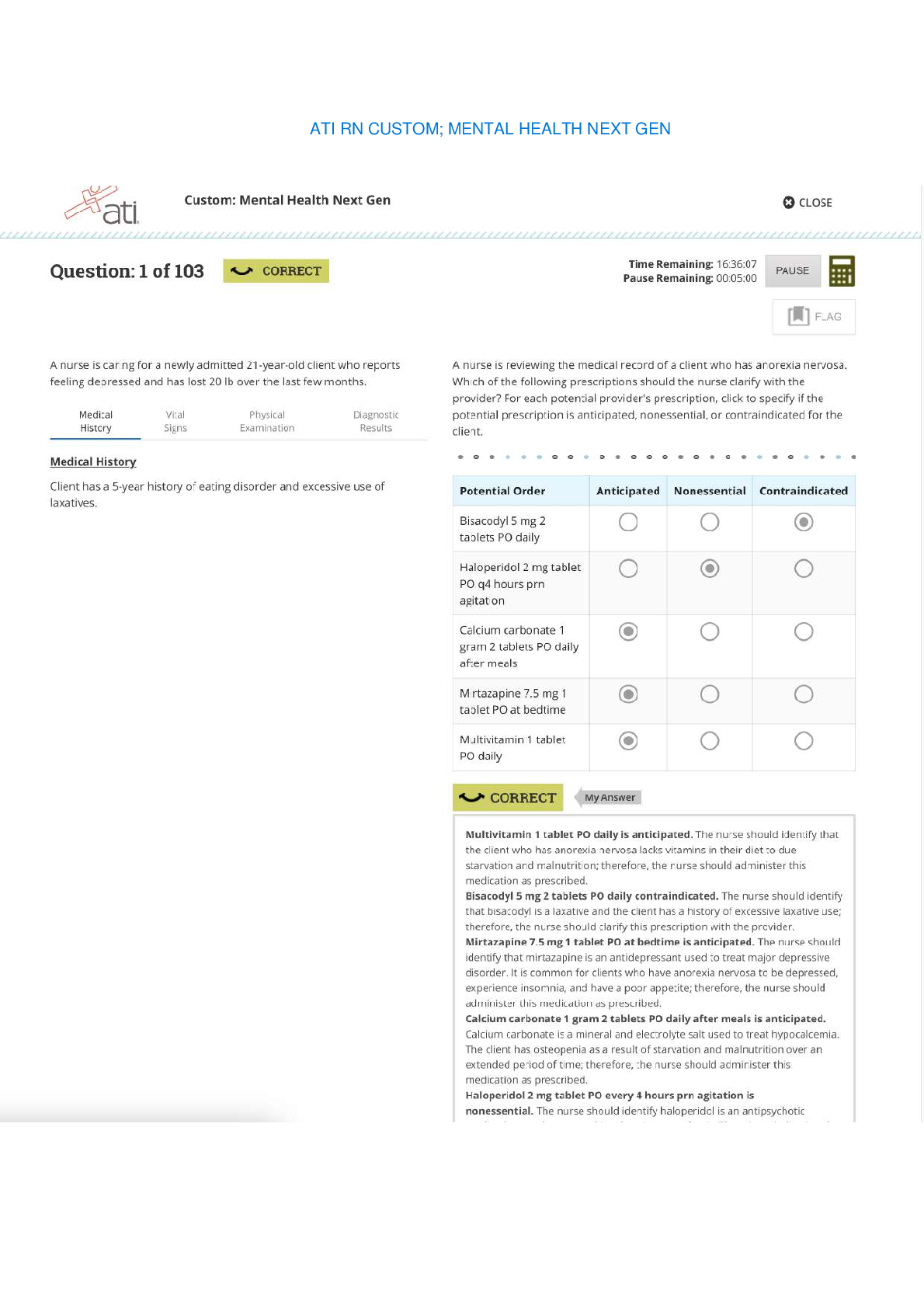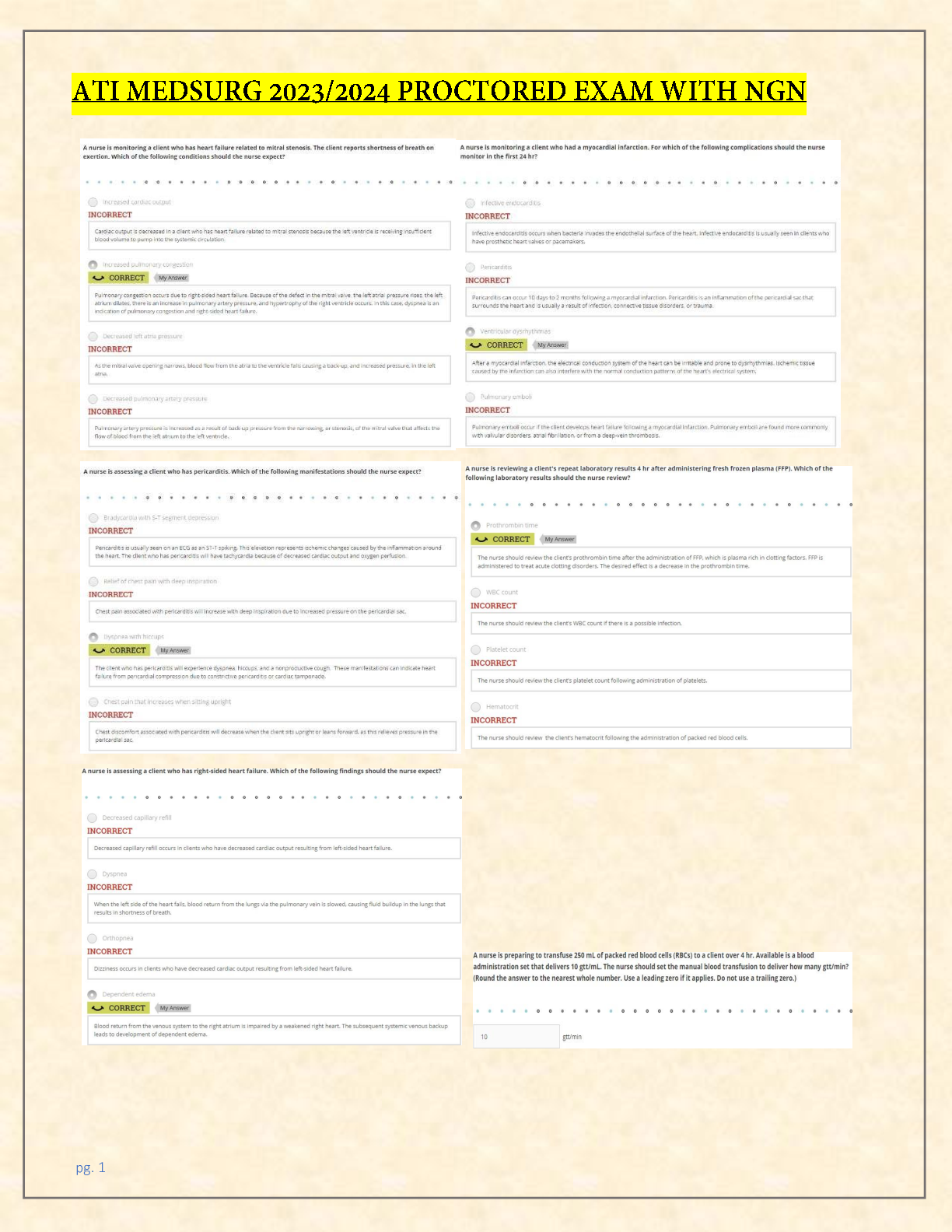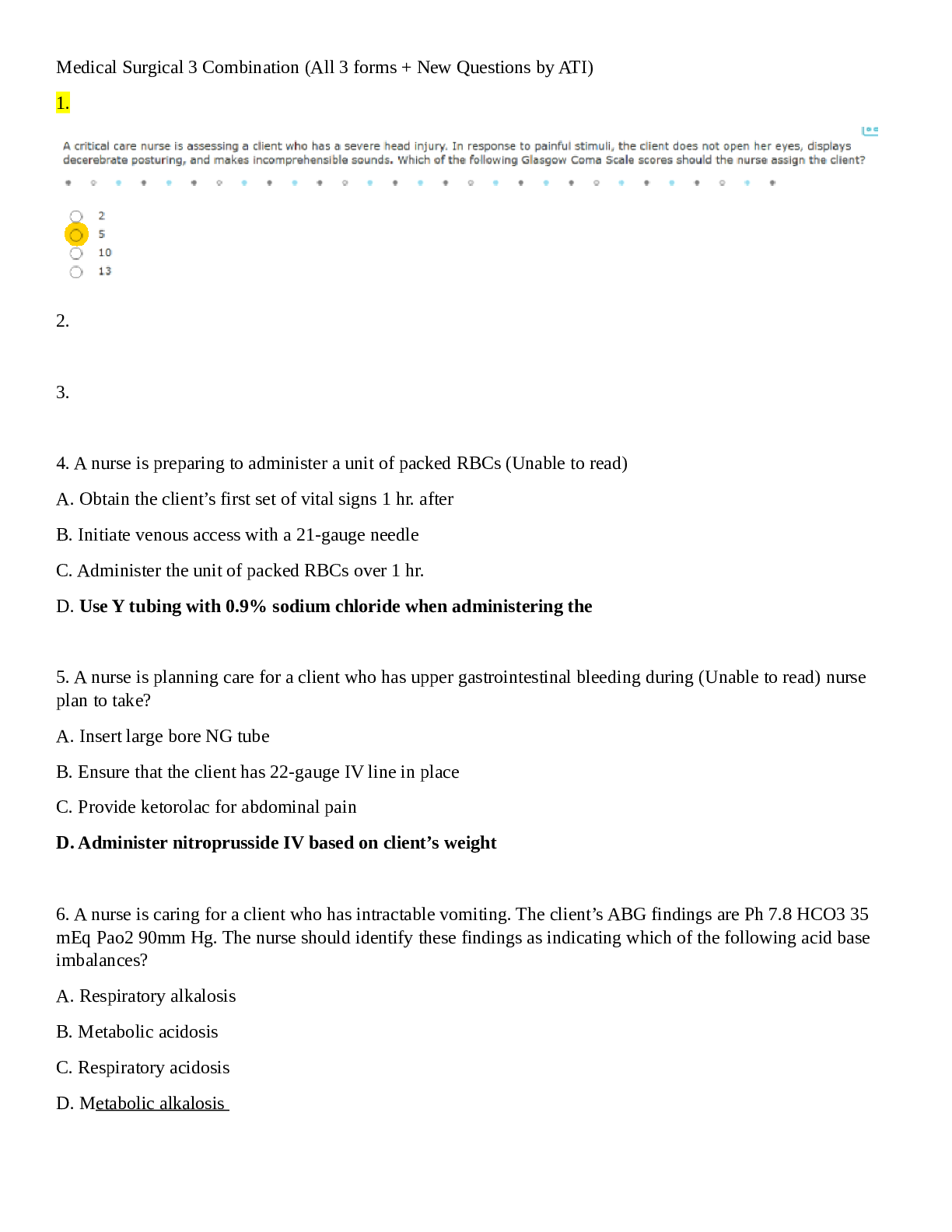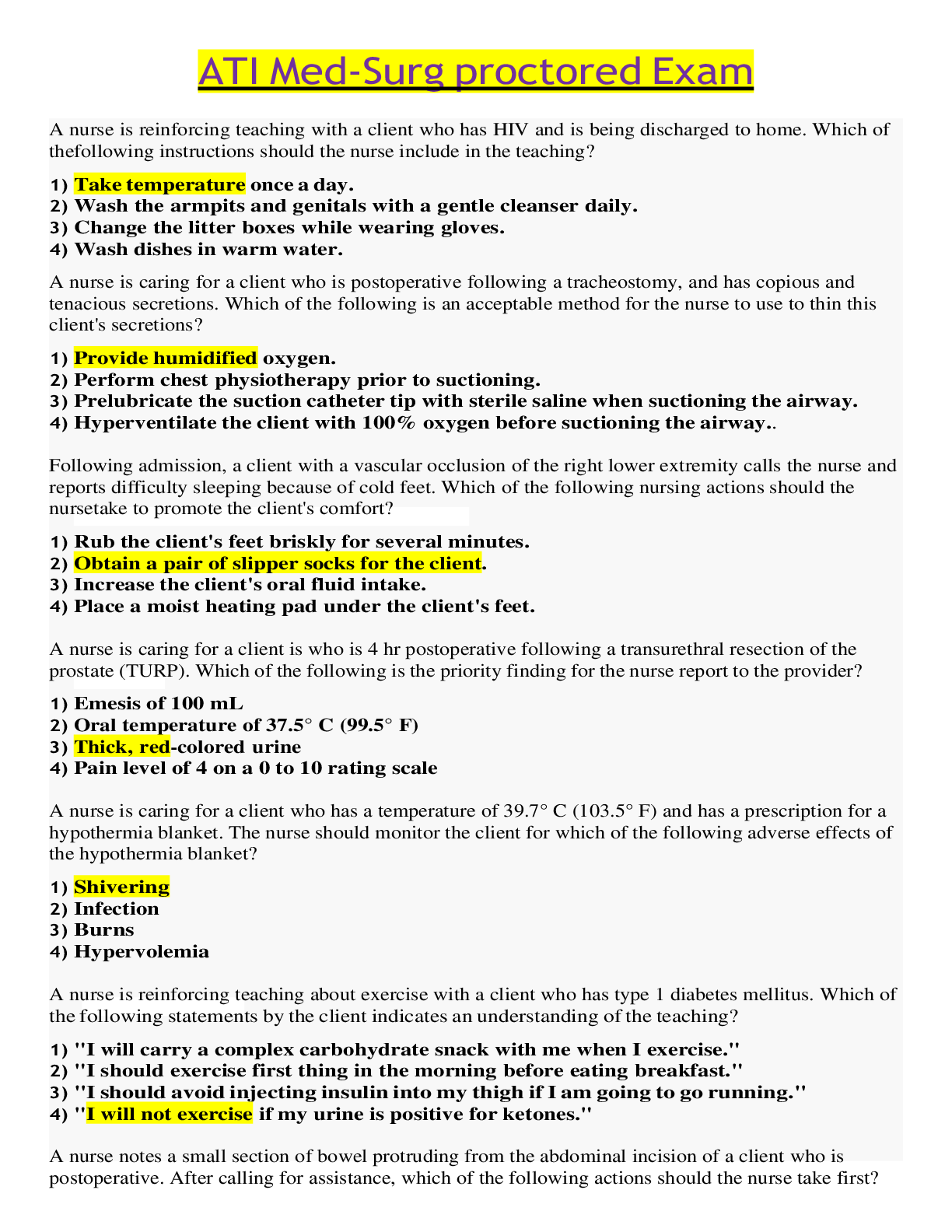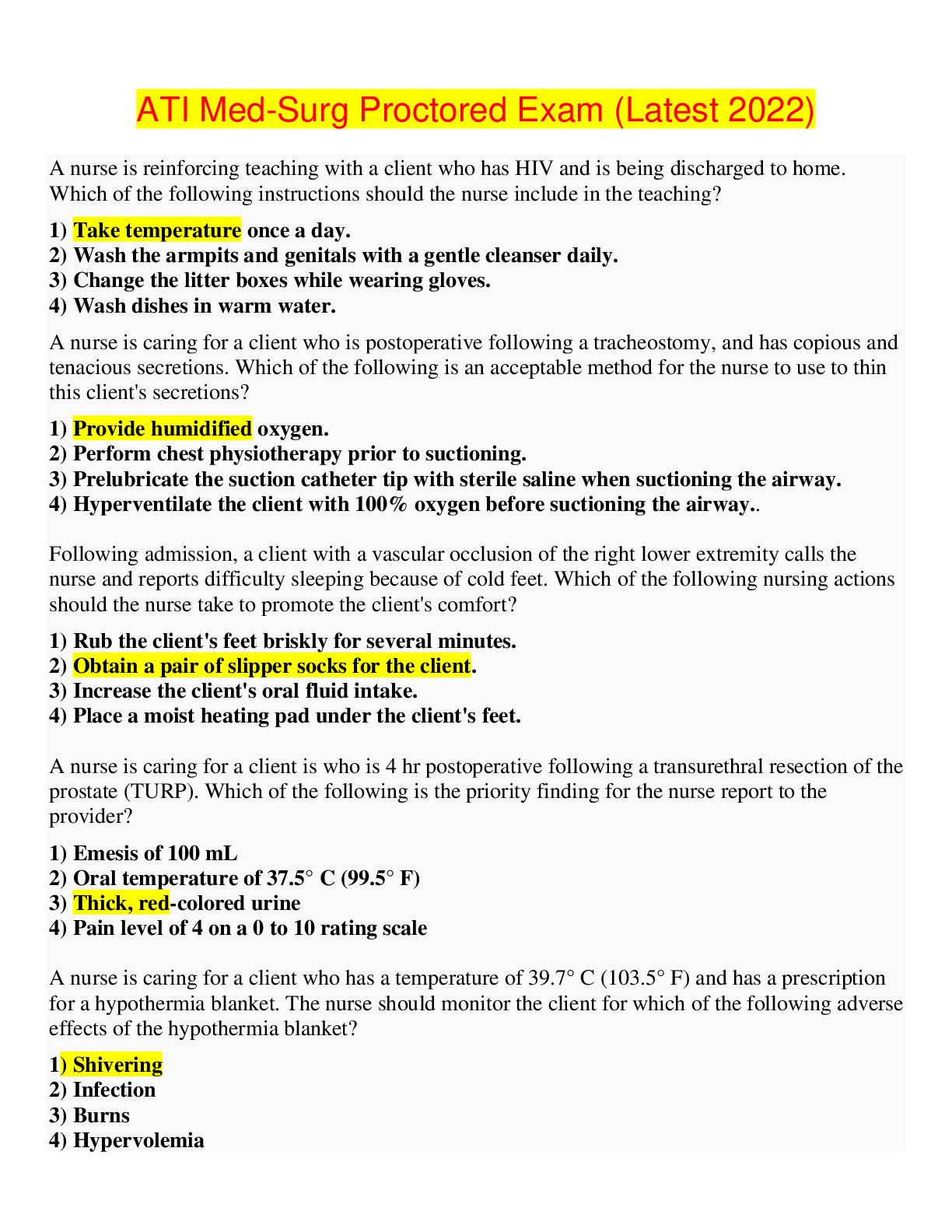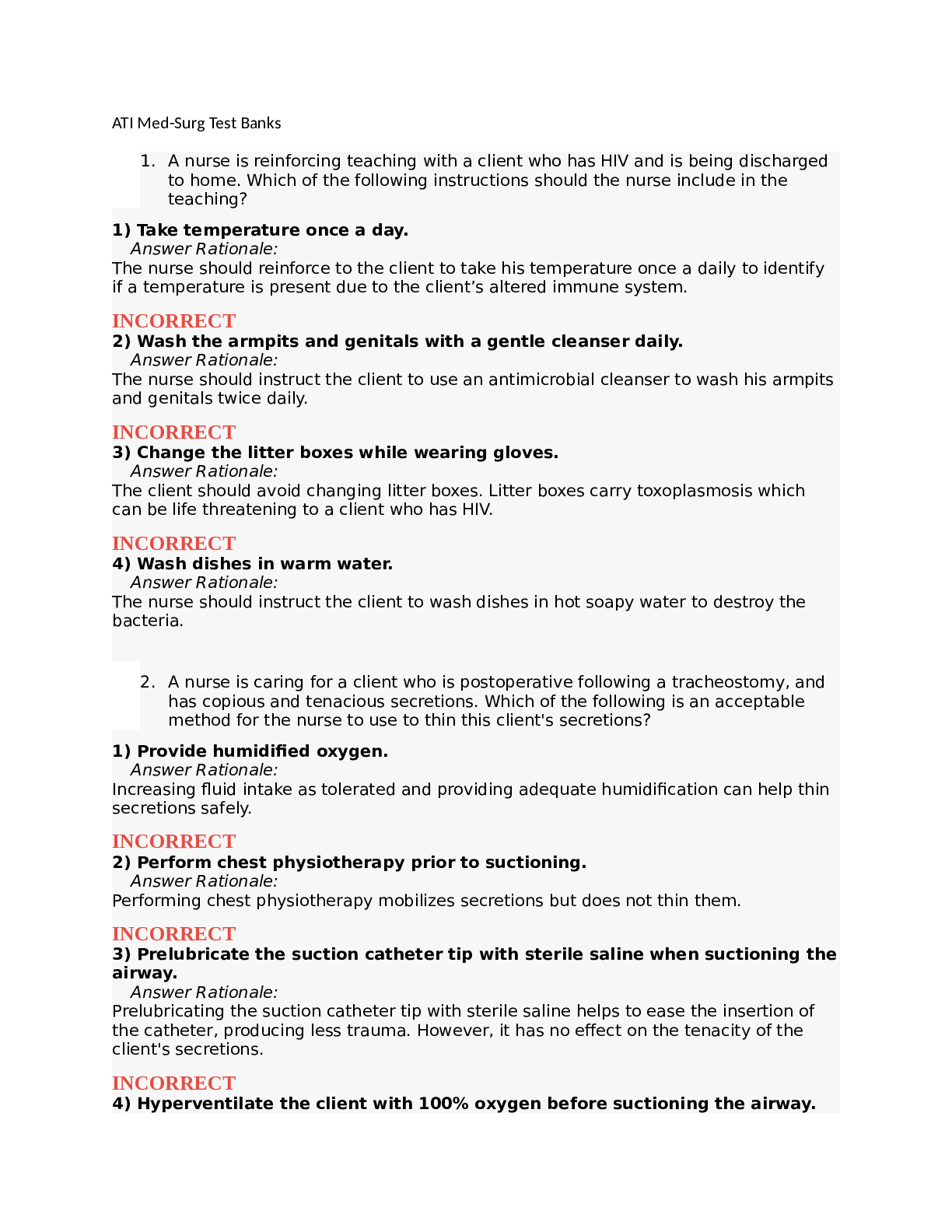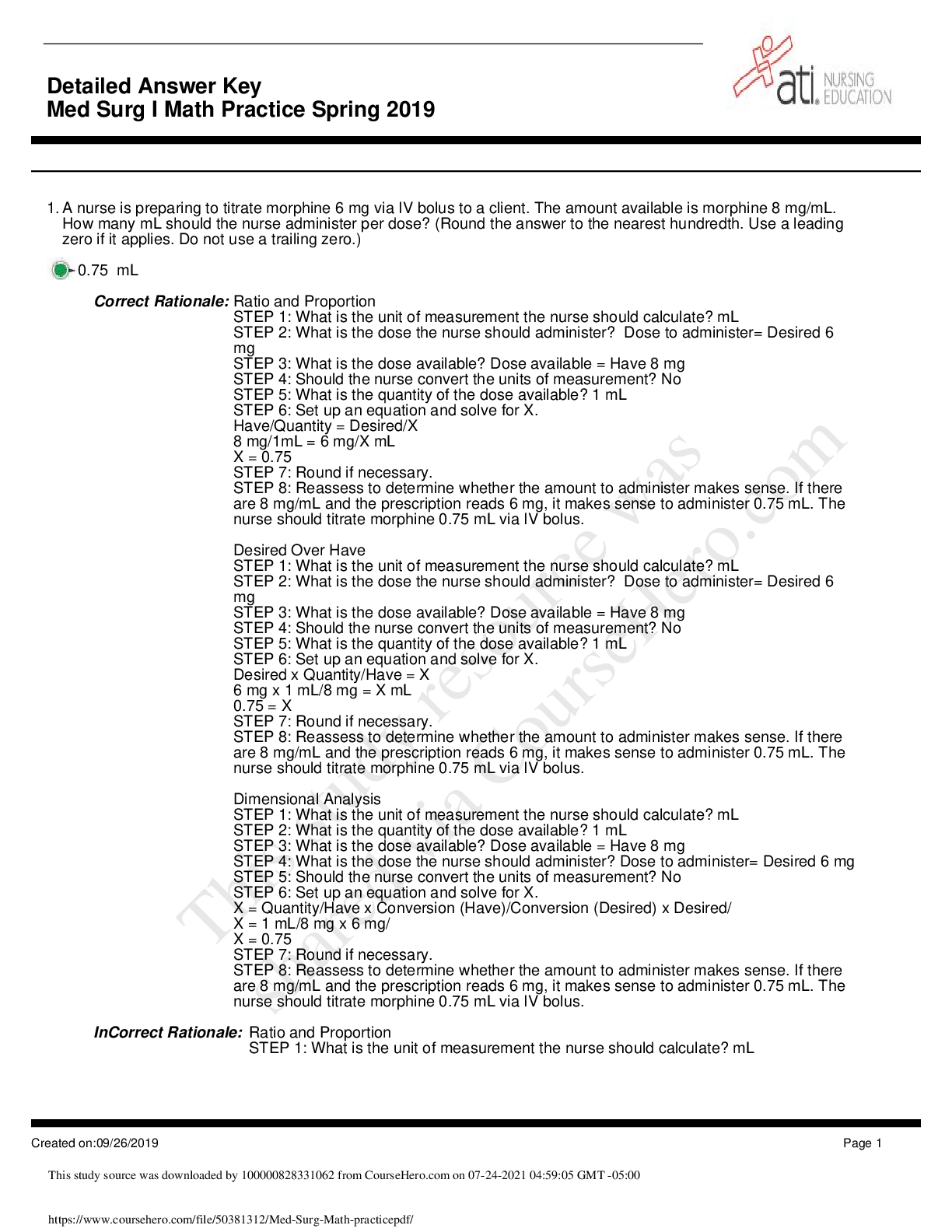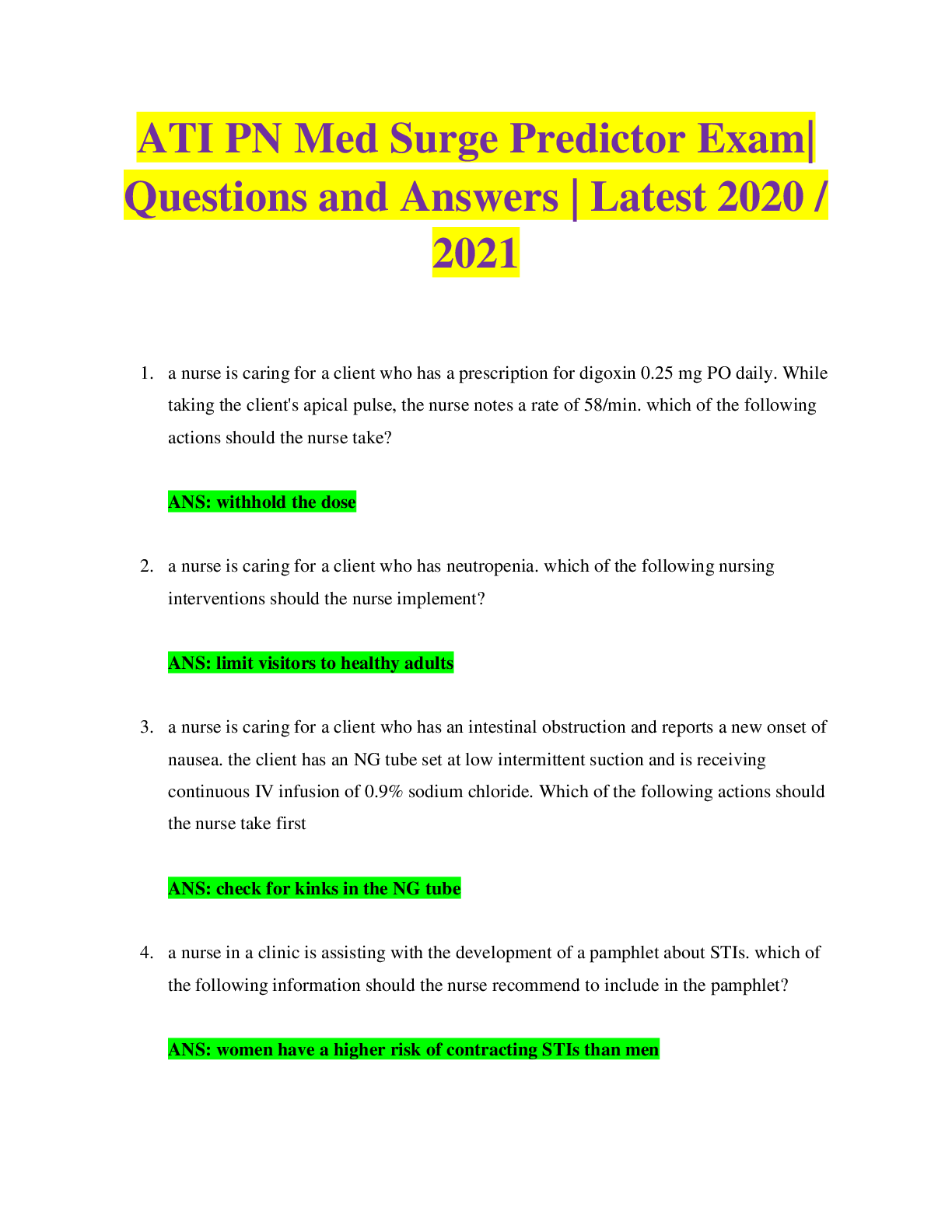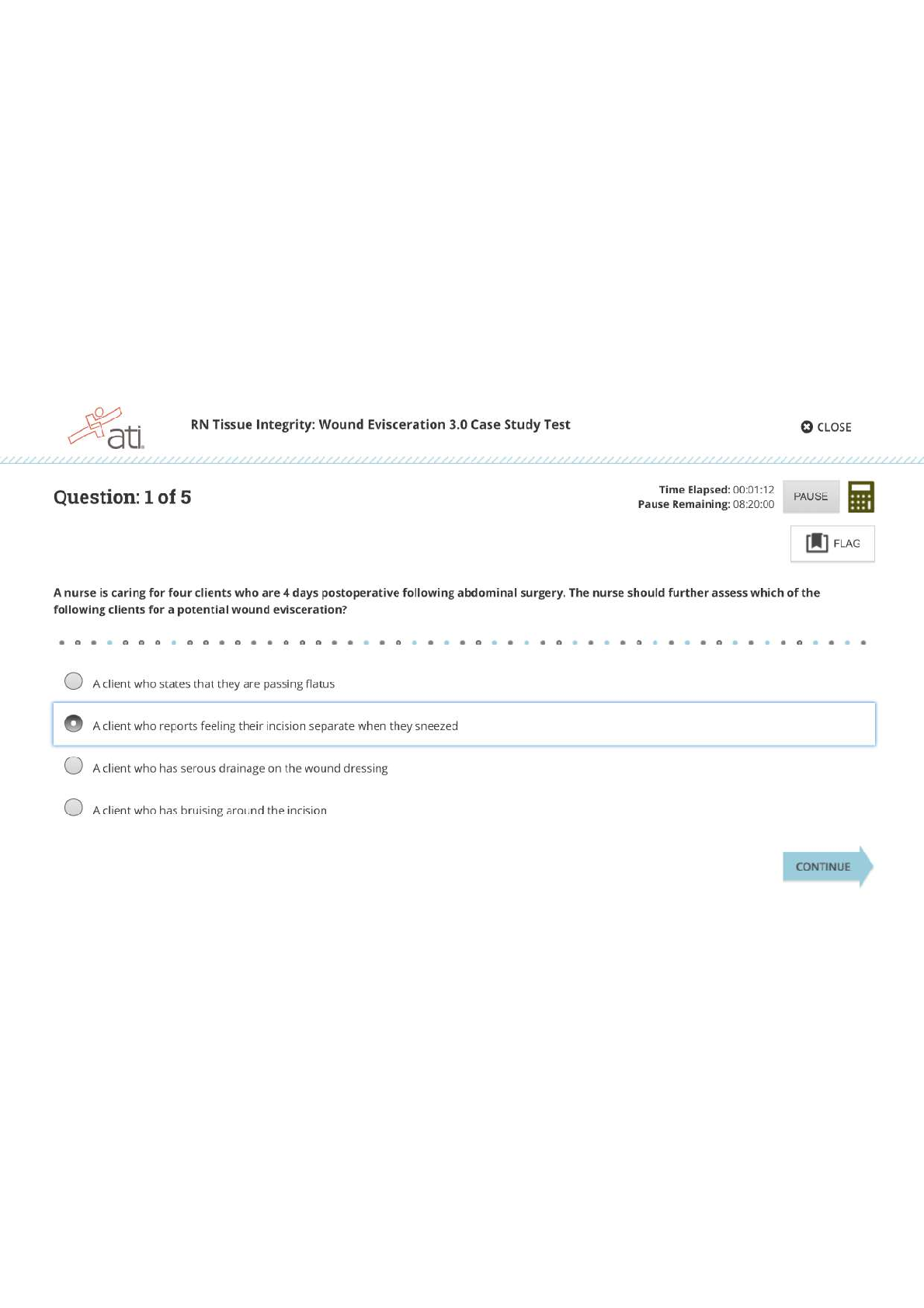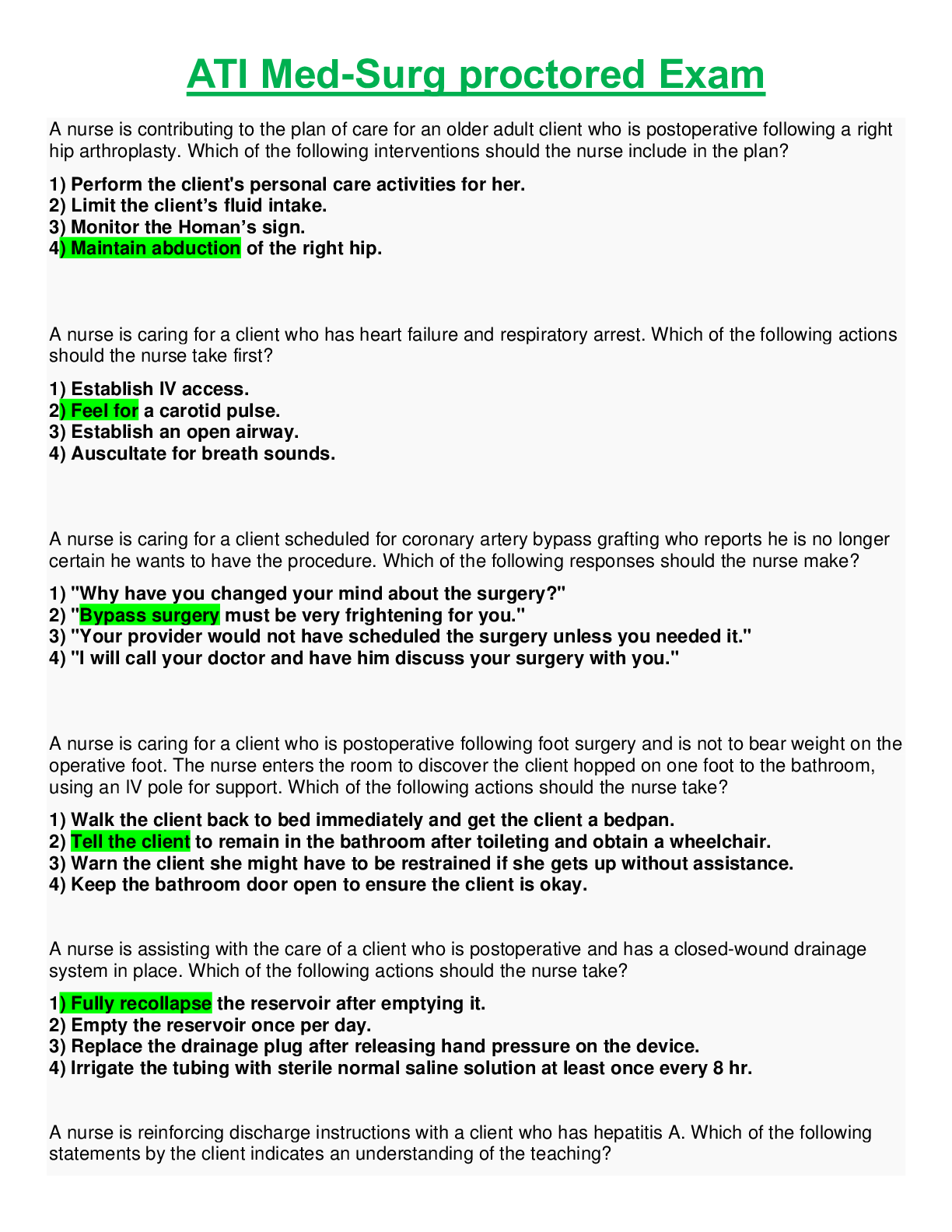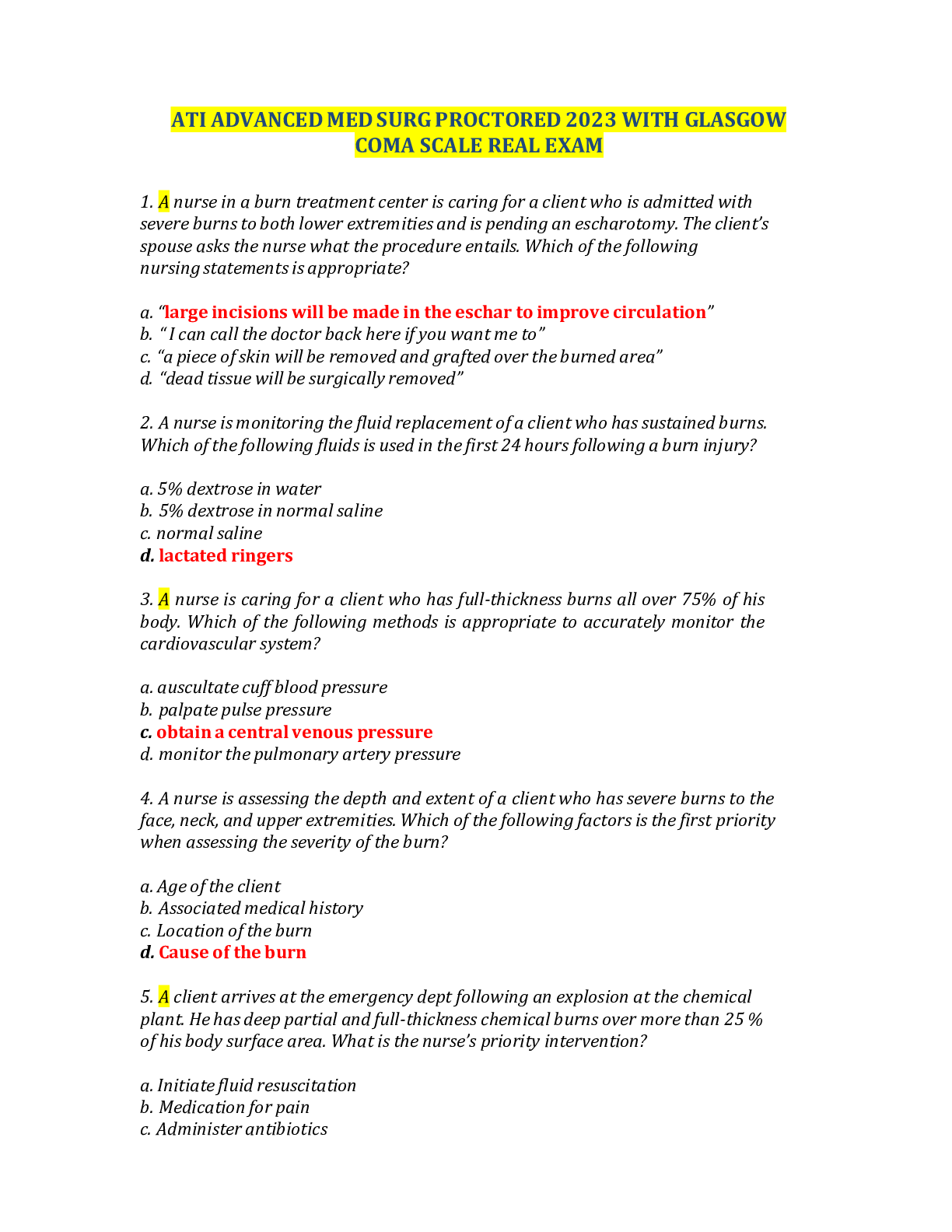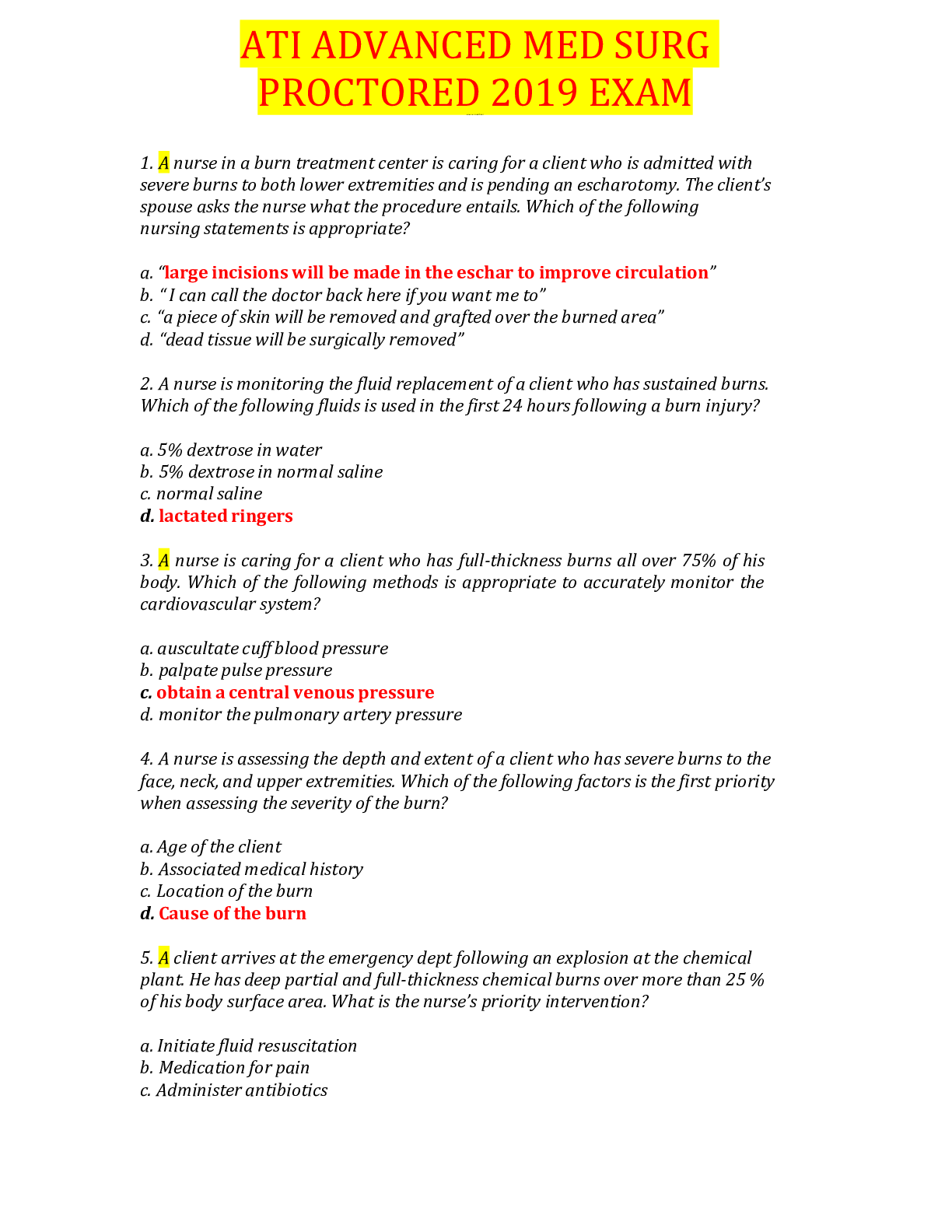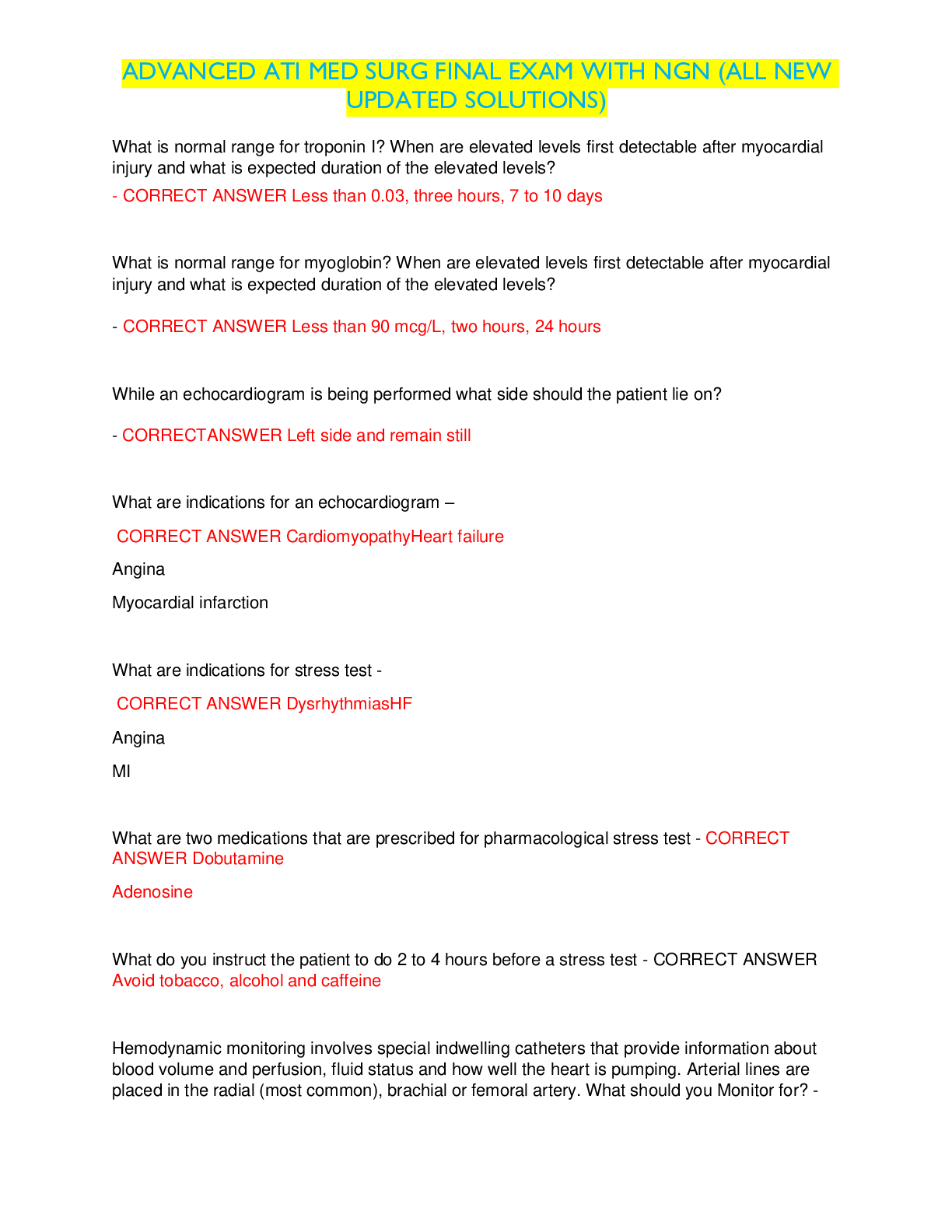Medical Studies > ATI MEDICAL SURGICAL > NURS 314 ATI COMPREHENSIVE 2.0_Mental 1 – Texas University | NURS314 ATI COMPREHENSIVE 2.0_Mental (All)
NURS 314 ATI COMPREHENSIVE 2.0_Mental 1 – Texas University | NURS314 ATI COMPREHENSIVE 2.0_Mental 1
Document Content and Description Below
NURS 314 ATI COMPREHENSIVE 2.0_Mental 1 – Texas University ATI-Comprehensive-Mental-1 1. Following abdominal surgery, a client's abdominal wound edges are separating, and the wound is draining... a large amount of serous drainage. Thenurse should place the client: Incorrect: This position is incorrect because it can increase tension on the suture line, and cause further wound separation and tearing (dehiscence).Incorrect: This position is incorrect because it can increase tension on thesuture line, and cause further wound separation and tearing (dehiscence).Correct: The semi-Fowler's position decreases tension on the wound, and it may prevent further separation and tearing of the wound(dehiscence).Incorrect: This position is incorrect because it can increase tension on the suture line, and cause further wound separation and tearing (dehiscence). flat on the back with legs straight. in high-Fowler's position with legs straight. in semi-Fowler's position with the knees slightly bent. on the left side with knees bent . 2. The PN is preparing to administer an enteral feeding to a client. To prevent gastric cramping and discomfort due to the feeding, the nurse should: Correct: Cold formula can cause gastric discomfort. With enteral feedings, particularly via gastrostomy tube, the formula reaches the stomach quickly, with little or no opportunity to be warmed, as oral feedings would as they pass through the mouth and esophagus.Incorrect: Tube placement is confirmed prior to beginning each feeding. This action does not prevent gastric discomfort. However, checking tube placement does help prevent the infusion of the formula into the lungs.Incorrect: To prevent gastric discomfort, the concentration of the tube feeding formula needs to be advanced gradually. Full-strength formula may cause gastric discomfort, especially when the first few feedings areadministered.Incorrect: The head of the bed should be elevated at least 30° during the feeding and for at least 30 minutes after feeding. This is done to reduce the risk of aspiration, however, not to prevent cramping and discomfort. allow time for the formula to reach room temperature prior to administration. determine tube placement once every 24 hours. prepare to administer full-strength rather than diluted formula. elevate the head of the bed during and after feedings. 3. The nurse is caring for a child with cystic fibrosis (CF). Which intervention willhelp to prevent respiratory complications? Incorrect: Clients with CF should not receive cough suppressant syrups. These children need to cough frequently to clear lung secretions.Correct: Nebulization with mist or aerosol therapy followed by chest physiotherapyhelps to keep secretions free-flowing. The pulmonary effects of CF are progressive, and bronchial secretions must bekept moist.Incorrect: The child should change positions frequently to promote drainage from the lungs, and promote aeration of the lungs.Incorrect: Children with CF can safely receive the pertussis vaccine. These children need protection from pertussis because this infection causes severe respiratory complications. Encourage the use of cough suppressant syrup. Give frequent nebulization treatments. Limit changing the child's position to conserve the child's need for oxygen. Withhold the vaccine for pertussis. 4. The nurse is caring for a client following insertion of a pacemaker. The client isplaced on continuous ECG monitoring because it will: Incorrect: This is incorrect because pacemaker voltage settings are adjusted manually at the time of insertion.Incorrect: A chest x-ray is used to check the placement of pacer wires after a pacemaker insertion.Correct: The heart rate may change following pacemaker insertion because the pacemaker fails to maintain the pre-set heartrate. This problem can be detected immediately with continuous ECG monitoring.Incorrect: Fluoroscopy is used to determine dislodgement of pacer leads after a pacemaker insertion. Dislodgement can be prevented with bedrest andminimal arm and shoulder activity. allow the primary care provider to adjust voltage settings. check placement of the pacer wires. detect a dramatic change in heart rate. determine dislodgement of pacer leads. 5. The nurse is administering eye drops to a client. To prevent injury, the nurse should: Incorrect: The nurse should ask the client to "look up" before instilling the eye drops. This action reduces stimulation of the corneal reflex and injury to the eye, should the client jerk away.Incorrect: Eye drops should never bedropped directly onto the cornea as this action may injure the cornea. The nurse should deposit the medication onto the lower conjunctiva.Correct: As a safety precaution, the nurse administering eye drops should rest his hand on the client's forehead. In case the client moves, the nurse's hand will move at the same time, lowering the risk that thedropper will hit the client's eye.Incorrect: When administering eye drops, it is essential to have an adequate amount oflight. However, the nurse should not shine a bright light directly into the client's eye. ask the client to "look down" before instilling the eye drops. drop the eye drops directly onto the client's cornea. rest his hand on the client's forehead. shine a bright light into the client's eye. 6. Which statement is true regarding the behavior of clients who are in pain? Incorrect: Many clients avoid conversation and social contacts when they are experiencing pain. Clients with chronic pain may become withdrawn and isolated.Incorrect: Clients' reactions to pain are often influenced by theircultural and ethnic background. The nurse needs to consider each client's cultural background when assessing a client's pain.Incorrect: Clients often place their hands over the painful area as a self-protective or guardingmechanism to prevent further pain.Correct: Many clients fail to report or discuss their pain or discomfort with nursesand other caretakers. Thus, the PN needs to assess clients for pain on a routine basis. Clients experiencing pain may engage in social activities for distraction. Clients from different cultures react to pain in the same way. Clients in pain usually avoid touching the painful area. Clients who are in pain may not report their pain to the nurse or other caretakers. 7. A client is being discharged from same-day surgery following cataract extraction from the right eye. The nurse will instruct the client to: Correct: Lifting requires straining, which increases pressure in the eye and may disrupt suture lines.Incorrect: The client should not bend forward or lower the head. This action increases pressure in the eye and could disrupt suture lines.Incorrect: Mild pain is normal. However, moderate to severe pain should be reported to the surgeon.Incorrect: The client should sleep on the unaffected (left side) to reduce pressure in the eye. Increased pressure could disrupt the suture lines. avoid lifting anything heavier than five pounds until cleared by the surgeon. bend from the waist to pick up objects on the floor. call the surgeon immediately if he has any discomfort. sleep on his back or on his right side. 8. Substance abuse is diagnosed when the person's involvement with drugs oralcohol: Incorrect: Substance abuse is likely to cause or contribute to family conflict. However, family conflict is not a diagnostic criterion for substance abuse.Incorrect: Substance abuse usually leads to physical health problems overtime. However, physical illness is not a diagnostic criterion for substance abuse.Correct: A client has a problem with substance abuse when that person begins to develop interpersonal difficulties, and is not able to perform their roleadequately at work or at school.Incorrect: A person abusing substances may come to the attention of the law. However, the development of legal difficulties are not a diagnostic criterion for substance abuse. causes family conflicts. causes physical illness. interferes with the person's ability to function. results in legal problems. 9. A newly employed nurse discovers that some medication doses are incorrect. Coworkers admit that changes in medication orders have not been processedcorrectly, but they advise the nurse to administer the medication anyway. The nurse should: Incorrect: This action is an unsafe practice, and it violates the five rights of medication administration.Incorrect: Reporting the incident to the State Board of Nursing is not the first step in resolving theissue.Correct: The nurse needs to inform the nurse manager about the unsafe medication practice and incorrect medication dosages. The nurse manager can then determine how to resolve this intradepartmental issue.Incorrect: Resigning will not resolve the issue and it will allow the unsafe practice to continue. give the dose that is available. report the incident with documentation to the State Board of Nursing. report this unsafe practice to the nurse manager. resign due to unsafe practices. 10. The nurse is teaching a client with tuberculosis about ways to reduce spreadof the disease to others. Teaching is effective when the client states: Incorrect: Tuberculosis is spread by droplet nuclei, and not through contact with the skin of an infected person.Incorrect: Tuberculosis is spread by droplet nuclei, and not through blood contact.Incorrect: Clients with tuberculosis need to cover their mouths when they laugh to reduce spread of the disease.Correct: Tuberculosis is spread by droplet nuclei. Thus, covering the mouth when coughing decreases the release of droplet nuclei into the air, and the spread of the disease to other people. "I can transmit tuberculosis to others by touching them." "I can transmit tuberculosis to others through contact with my blood." "I don't need to cover my mouth when I laugh." "I'll cover my mouth with a tissue when I cough." 11. The nurse performs a physical assessment on a newborn baby. Which finding, if noted, is abnormal and needs to be reported? Incorrect: Apnea lasting 5-15 seconds is periodic apnea, and is normal for the newborn. No intervention is required as long as there is no change in the infant's heart rate.Incorrect: A blue color in the fingers and toes is called acrocyanosis, and it is a normal finding in the newborn in the first couple of days after birth.Incorrect: Gagging orchoking is common in the hours following birth because the infant was in a fluid-filled environment for the gestation. There should be a bulb syringe in the infant's crib at all times to suction the mouth, pharynx, and nose, and clear theairway as needed.Correct: Normal respirations range for the newborn is 30-60 respirations per minute. Rapidbreathing is a sign of respiratory distress, which may indicate sepsis or other complications and should be reportedimmediately. Apnea lasting 5 to 15 seconds Blue color in the fingers and toes Gagging or choking Respirations of 80 per minute 12. The nurse is providing discharge teaching to a client who is at high risk forinfection. The client asks if there is any way to prevent getting a cold. Whichresponse from the nurse is correct? Incorrect: The common cold is caused by a virus. Antibiotics are not prescribed for the common cold.Incorrect: This is not practical advice, and it does not necessarily eliminate exposure.Incorrect: A mask may decrease risk of infection, but it is not the most effective measure.Correct: Handwashing is the most effective preventive measure for a cold. "Ask your doctor for an antibiotic that you can take." "Stay indoors during the height of cold and flu season." "Wear a mask when going outdoors during cold and flu season." "Wash your hands frequently during cold and flu season." 13. The nurse is interviewing the wife of a client who is in the middle stage ofAlzheimer's. The wife tells the nurse that she wants to keep her husband at homeas long as possible. Which response by the nurse is most helpful? Incorrect: This statement is not supportive of the wife. The wife may be quite capable of providing care, especially with instruction and other assistance.Incorrect: Some clients with Alzheimer's disease become aggressive, but not all. If aggression occurs, the client can be treated with medication or behavioral interventions.Correct: Withsupport and education, a family caregiver may be able to provide an appropriate home environment for the client with Alzheimer's disease. This reply accepts the wife's wishes and offers practical help.Incorrect: This comment is not supportive of the wife. It assumes that the nurse knows what is best in this situation. Realistically, only the wife can make this important decision. “It is not realistic for a person your age to care for a client diagnosed with Alzheimer's disease." "Keeping your husband at home could be dangerous. Alzheimer's clients may become violent." "Let's talk about the help you will need so you can continue to care for your husband at home." "To maintain your own health, you need to consider nursing home placement for your husband." 14. The nurse is caring for a client with Buck's traction. In which situation mustthe nurse intervene in order to maintain effectiveness of the traction? Incorrect: This is a correct application of the traction boot. The Velcro straps keep the boot in place to promote effective traction pull.Correct: Effective traction requires the client to be in good body alignment. This positionis out of alignment and requires intervention. Improper body position may decrease the effectiveness of the pull from the traction.Incorrect: This is the correct position for the footplate because it promotes effective traction. If the footplate is placed against the footboard of the bed, effective traction may not be achieved.Incorrect: This is a correct setup for the traction. If weights are resting on the bed or the floor, the force or line of pull of the traction is disrupted. The boot is secured by three Velcro straps around the leg. The client is lying with hips midline and shoulders to the left of midline. The traction footplate is resting 6 inches from the footboard. Traction weights are hanging freely at the foot of the bed. 15. What is the purpose of the Apgar score after birth? Incorrect: Apgar scores do not correlate with the gestational age, and are not used for this purpose.Incorrect: Although babies that score low on the Apgar may be transferred to the ICU, this is not the purpose of the Apgar.Correct: The one-minute and five-minute Apgar is a ten-point scoring tool used to assess the need for resuscitation systematically in the newborn. This score reflects the baby's physical condition at birth.Incorrect: Apgar scores are not used to evaluate the baby for long-term health needs or health problems. To estimate gestational age To determine if the baby needs to be transferred to the intensive care unit (ICU). To determine if the newborn needs resuscitation. To predict if the baby will have long-term problems. 16. A client with severe emphysema has a moon face and a buffalo hump related to long-term steroid treatment. The client states, "I look so horrible." Whichresponse by the nurse is therapeutic? Incorrect: This is a judgmental statement, it has no bearing on disease etiology in this case, and it does not address the client's anxiety about a distressing change in appearance.Incorrect: This is not a therapeutic response. The client's symptoms are related to long-term steroid use and not overeating. Also, the nurse is not addressing the client's anxiety about a distressing change in appearance.Correct: This is a therapeutic response. This response indicates that the nurse is receptive to listening to the client's feelings about distressing body imagechanges.Incorrect: This is not a therapeutic response. The nurse is not addressing the client's anxiety about a distressing change in appearance. "If you hadn't smoked all those years, this would not have happened." "I will refer you to the dietician for a weight-loss diet." "This must be very upsetting for you. Would you like to talk about it?" "You must try to get used to your appearance as you need to take steroids." 17. A client develops wheals as a result of an allergic reaction to a medication. When documenting the reaction, the nurse correctly describes a wheal as: Incorrect: This is a description of a macule, not a wheal. Freckles or flat moles are examples of macules.Incorrect: This is a description of a papule, not a wheal. Warts or elevated nevi are examples of papules.Incorrect: This is a description of scales, not wheals. Dandruff or dry skin are examples of scales.Correct: This is the correct description of a wheal. Urticaria (or hives) is characterized by the development of wheals. a flat, nonpalpable, brown lesion with an irregular boarder. a slightly elevated, palpable mass with a clearly defined border. fine, silvery-white, irregularly-shaped flakes that adhere to the skin. an itchy, elevated, reddened mass with an irregular border and shape. 18. A 7-year-old child arrives in the emergency department with multiple injuries and bruises that are in different stages of healing. The parents report that thechild received injuries on the legs and torso from falling off a bike. What is thelaw in this situation? Incorrect: It may be helpful for a counselor to interview the child and the parents, and provide counseling. However, counseling is not a requirement in this situation.Incorrect: Any health care provider who observes suspicious injuries on a child must report abuse. Reporting abuse is not the sole responsibility of primary careproviders.Incorrect: Bike safety is important, but this child's injuries are more suspicious of abuse than a fall from abike.Correct: By law, suspicious injuries such as bruises on various parts of a child's body must be reported to the authorities. Child Protective Services is the agency that oversees the protection of children from abuse. A counselor must talk with the child and the parents. A primary care provider must notify authorities of suspected abuse. The child must be taught bike safety. The child's injuries must be reported to Child Protective Services. - - - - - - - - - - - - - - - - - - - - - - - - - - - - - - - - - - - - 151. The nurse is planning care for a 16-year-old client diagnosed with Hodgkin'sdisease. Which nursing diagnosis is the nurse most likely to find on the client'scare plan? Incorrect: Hodgkin's disease does not impair gas exchange.Incorrect: Hodgkin's disease does not cause fluid volume problems.Incorrect: Hodgkin's disease produces painless enlarged lymph nodes.Correct: The course of treatment for Hodgkin's disease is long and difficult. Some adolescents with this disease live from day to day wondering if symptoms will reoccur. Gas exchange, impaired Fluid volume deficit Potential for acute pain Risk for powerlessness 152. The nurse is assessing a 16-year-old girl diagnosed with anorexia nervosa. Which symptom will the nurse expect to observe? Correct: Clients with anorexia nervosa may have arrested or delayed sexual development due to extreme malnutrition.Incorrect: Clients with anorexia nervosa may experience hypothermia, not hyperthermia.Incorrect: Mostpatients with anorexia nervosa have hypotension, not hypertension.Incorrect: Clients with bulimia nervosa may havea normal body weight, while clients with anorexia nervosa have a very low body weight. Amenorrhea Hyperthermia Hypertension Normal to slim weight range 153. Which activity can reduce a man's risk for cancer of the prostate? Correct: The American Cancer Society recommends annual screening for prostate cancer beginning at age 50. Clients should begin screening at age 40 if they have other risk factors for cancer. The most effective screening procedures are digital rectal examination and the prostate-specific antigen (PSA) test.Incorrect: Cigarette smoking isnot a risk factor for prostate cancer. Major risk factors related to prostate cancer include family history, history of sexually transmitted diseases, a high-fat diet, and a sedentary lifestyle.Incorrect: Vasectomy will not decrease the riskfor prostate cancer.Incorrect: TSE will not reveal the development of prostate cancer, but it can reveal early testicular cancer. Annual screening beginning at age 50 Entering a smoking cessation program Having a vasectomy before age 35 Performing a monthly testicular self-examination (TSE) 154. When counseling a client with coronary artery disease who is on a low- sodium diet, the nurse will encourage the client to eat which foods? Correct: Fresh fruits are low in sodium and are nutritious. The USDA's Food Guide Pyramid recommends two to four servings of fresh fruit daily.Incorrect: Muffins and processed bran cereal are high in sodium, and are not included on a low-sodium diet. Clients on low-sodium diets should use low-sodium baking powder for baking muffinsand other items.Incorrect: Instant potatoes are high in sodium and are not included on a low-sodium diet. The client can eat boiled potatoes, which are low in sodium.Incorrect: Tomato juice and V-8 juice are high in sodium and are not included on a low-sodium diet. Other juices, such as apple, orange, grapefruit, and grape, are recommended in small amounts. Fresh fruit Bran muffins Instant potatoes Tomato juice 155. When caring for hospitalized clients and observing standard (universal) precautions, the nurse does not need to wear clean gloves when: Correct: Gloves are not required when caring for a client with intact skin. Gloves are required when touching body fluids, excretions, secretions, mucous membranes, and non-intact skin.Incorrect: Sterile gloves are required inthis situation to reduce the transmission of infection-causing bacteria.Incorrect: Gloves are required during exposureto body fluids for the protection of the nurse from infectious diseases.Incorrect: Sterile gloves are required forinsertion of an indwelling urinary catheter device. Clean technique prevents the ascent of contaminant bacteria intothe urinary tract. bathing a client with intact skin. changing a dressing with drainage. changing linens of an incontinent client. draining a urinary catheter bag. 156. The nurse is performing a postpartum assessment. The client has a positiveHoman's sign, which may indicate: Incorrect: Involution is the return of the uterus to the nonpregnant state following birth. This process is not indicated by a positive Homan's sign.Incorrect: A positive Homan's sign does not indicate nerve damage. It is a clinical finding that may indicate thrombophlebitis. The nurse needs to report this finding immediately.Incorrect: Apositive Homan's sign may indicate inflammation, but not infection.Correct: A positive Homan's sign is characterized by pain in the calf or behind the knee when the client's foot is dorsiflexed. It is an early sign of femoralthrombophlebitis and the nurse needs to report the finding immediately. involution. popliteal nerve damage. postpartum infection. thrombophlebitis. 157. A mother with gestational diabetes has just delivered a newborn baby. To prevent newborn hypoglycemia, the nurse should anticipate having to: Incorrect: Infants born to diabetic mothers should not require intensive care if they receive regular feedings, and are closely monitored for hypoglycemia.Correct: Feeding the infant at regular intervals maintains a stable glucoselevel. Jitteriness and lethargic behavior indicate hypoglycemia in the newborn.Incorrect: Infants born to diabeticmothers develop hypoglycemia, not hyperglycemia. The use of insulin is not indicated.Incorrect: Infants born to diabetic mothers usually do not receive a high-calorie formula during the first 24 hours. Early enteral feeding withstandard 20 calories/ounce formula or breast milk is usually effective in maintaining a normal blood glucose level. arrange to transfer the infant to the Intensive Care Nursery. monitor the infant's blood glucose levels and provide enteral feedings. monitor the infant's blood glucose levels, and provide sliding-scale coverage with insulin. provide the infant with 27 calories/ounce formula for the first 24 hours of life. 158. Two clients diagnosed with myasthenia gravis have been admitted. One is inmyasthenic crisis; the other is in cholinergic crisis. Which initial assessment iscritical for both clients? Correct: Both myasthenic crisis and cholinergic crisis result in profound muscle weakness, thus both clients are at risk for hypoventilation. As a result, both may require mechanical ventilation. Therefore, it is critical to assess respiratory status immediately.Incorrect: It is important to assess level of consciousness, but it is not the most critical initial assessment.Incorrect: It is important to assess pupil activity, but it is not the most critical initial assessment.Incorrect: Urine output and characteristics are not affected by complications of myasthenia gravis. Breathing and oxygenation Level of consciousness Pupil response to light Urinary specific gravity 159. A client reports that he is hearing voices that are condemning him. Which is the best response from the nurse? Incorrect: This response demonstrates doubt or questioning, and hints that the nurse does not believe or acknowledge the client's experience.Incorrect: Telling the client that the voices are not real fails to acknowledge the client's experience. This response may provoke an argument, because the voices are real to the client.Incorrect: While it is important to acknowledge the client's experience, it is not therapeutic to question whether the clientconverses with the voices.Correct: This response clarifies reality for the client and still acknowledges the client's feelings. "Are you positive you hear voices? Maybe you are hearing noises from the TV." "Certainly you realize that these voices are not real." "Did you listen to the voices and talk with them?" "I don't hear any voices, but I think it would be frightening to hear voices condemning me." 160. Which task may be delegated by the nurse to unlicensed assistivepersonnel? Incorrect: This assignment is beyond the scope of practice for unlicensed assistive personnel.Correct: A client who is two days post-surgery will usually be active and involved in self-care. Unlicensed assistive personnelcan safely bathe this client.Incorrect: This assignment is beyond the scope of practice for unlicensed assistive personnel.Incorrect: This assignment is beyond the scope of practice for unlicensed assistive personnel. Assessing a client during the immediate postoperative period. Assisting a client who is two days postoperative with bathing. Discussing discharge planning needs with a family. Regulating the infusion rate of continuous bladder irrigation. 161. The nurse is assessing an adult client's vital signs. Which assessmentfinding requires further evaluation? Incorrect: Usually there is a variation between apical heart rate and radial pulse, and thus this is a normal finding. An excessive pulse deficit (difference between heart rate and radial pulse) may indicate an alteration in cardiac output.Incorrect: An elevated pulse rate is an expected finding in an adult client experiencing acute pain. Acute pain and anxiety increase sympathetic stimulation, which increases heart rate.Correct: A weak, thready radial pulse that is difficult to palpate is an abnormal finding in an adult. This finding may indicate disease or the development of an emergency such as hemorrhagic shock.Incorrect: The normal respiratory rate for an adult is between 12-20 breaths per minute. Normally, respirations are slower during sleep. Thus, a respiratory rate of 14 breaths during sleep is a normal finding. An apical heart rate of 78 beats per minute and a radial pulse of 77 beats per minute A radial pulse of 102 in a client who reports acute pain A weak, thready radial pulse that is difficult to palpate A respiratory rate of 14 breaths per minute during sleep 162. When teaching a paraplegic client to use a wheelchair, the nurse stresses the need to shift body weight every 15 minutes because: Incorrect: Muscle spasms may occur in paraplegia, but they are not caused by a failure to change positions.Incorrect: While repositioning does help maintain arm strength, it is not the main reason for repositioningwhile in a wheelchair.Incorrect: Muscle mass in the legs can be maintained only by active exercise, which is not possible with paraplegia.Correct: Changing positions improves circulation to the buttocks and sacrum, which preventsskin breakdown. remaining in one position causes muscle spasms. repositioning strengthens the arms, which makes it easier to transfer. repositioning will maintain muscle mass in the legs. shifting body weight helps prevent skin breakdown. 163. A nurse is assessing an African-American client who is depressed. Which factor is a major obstacle to culturally-sensitive assessment and care? Correct: Stereotyping is an unsubstantiated assumption that all people of a certain race, gender, ethnicity, or socioeconomic background are alike. It is important for the nurse to overcome stereotyping when caring forclients.Incorrect: Although it is helpful for nurses to recognize how their own cultural beliefs differ from those of their clients from other cultures, it is not a major barrier to delivering culturally sensitive care.Incorrect: A nurse who accepts cultural differences can provide culturally sensitive care to clients from different cultures. It is not necessary to belong to the same cultural group.Incorrect: Nurses cannot be expected to understand the values of every culture they might encounter in delivering care. It is certainly helpful to understand a particular client's cultural values, but it isstill possible to be culturally sensitive without a detailed knowledge of each culture. The tendency to stereotype clients A lack of interest in one's own cultural heritage A personal ethnicity different from that of the client A lack of understanding of the client's cultural values 164. Proper technique for giving oral hygiene to a client on bedrest includes: Incorrect: Foam swabs are useful for removing debris from the mouth, but do not effectively remove plaque from the teeth.Incorrect: Dentures are cleaned more effectively when removed. If the client feels uncomfortable aboutremoval, the nurse should offer the client privacy during removal, and then return to take the dentures to the sink for cleaning.Incorrect: Although hydrogen peroxide provides foaming action, it can irritate oral mucosa and alter the normal flora of the mouth, predisposing the client to infection. Normal saline solution is a better choice.Correct: Calledthe sulcular technique, this method of brushing the teeth not only removes plaque, but also cleans effectively under the margins of the gums. using foam swabs to remove plaque from the teeth, as they are less abrasive to the gums than toothbrushes are. brushing dentures while they are in place in the mouth, as some clients feel self- conscious about removing their dentures. using hydrogen peroxide to cleanse the oral mucosa of comatose clients, as its foaming action will help mobilize adherent debris in dried secretions. cleaning the teeth by angling the toothbrush 45 degrees to the teeth and gums, as this will help clean under the gingival margins. 165. Preschool children who are developing normally usually engage in whichtype of play? Correct: Children in the preschool years play together in a similar activity. Their play is not organized, and there are no rules or responsibilities.Incorrect: School-age children engage in cooperative play. In cooperative play, children play within an organized structure.Incorrect: Observational play is typical of infants. The baby intently watches others play, but does not actively engage in play activities.Incorrect: Parallel play is typical of the toddler years. This play style has two children playing side by side, but seldom interacting with each other. Associative play Cooperative play Observation Parallel play 166. The nurse is caring for a client who is receiving an intravenous infusion of 5percent dextrose in water. After multivitamins are added to the infusion, the clientreports severe itching. The client is most likely experiencing: Correct: An allergic reaction may develop following the administration of any intravenous medication, including vitamins. The nurse should immediately notify the primary care provider because severe itching is a clinical sign of allergy.Incorrect: The client's symptom of itching is not consistent with fluid-volume overload. Signs of fluid overload include shortness of breath and abnormal breath sounds.Incorrect: The client's symptom of itching is not consistent with intravenous infiltration. Intravenous infiltration occurs when a needle or catheter penetrates throughthe vein and fluid leaks into the surrounding tissues, producing swelling.Incorrect: The client's symptom of itching is not consistent with phlebitis. Signs of phlebitis include a swollen, warm, reddened intravenous site that is tender tothe touch. an allergic reaction. fluid volume overload. intravenous infiltration. phlebitis. 167. A client is concerned about sexual relationships following a mastectomy. Which nursing diagnosis will the nurse most likely find on the client's care plan? Incorrect: This client may develop a body image disturbance due to the loss of a breast. This nursing diagnosis does not specifically address the woman's concerns about her sexuality following a mastectomy.Correct: A woman who expresses concern about her sexuality following mastectomy is at risk for altered sexuality patterns. The client may report difficulties, changes, or limitations in sexual activities or behavior, as well as feelings of loneliness and loss.Incorrect: Skin integrity may be impaired following a mastectomy, and it may impede sexual relationships. This nursing diagnosis does not specifically address the woman's concerns about her sexuality followingmastectomy.Incorrect: Low self-esteem and negative feelings may occur following a mastectomy. This nursing diagnosis does not address the client's concerns about her sexuality. Body image disturbance Risk for altered sexuality patterns Risk for impaired skin integrity Situational low self-esteem 168. The nurse is obtaining a health history from a client with asthma. Whichinformation is most helpful to know when planning interventions to prevent futureasthma attacks? Incorrect: While it is important to determine the client's understanding of the disease state and anticipated interventions, it is more important that the nurse initially obtain a thorough health history. For healthier living, the nurse and client together may plan ways to modify the home environment and avoid precipitating asthmaticevents.Incorrect: Although the definitive diagnostic workup usually includes pulmonary function tests, initially the nurse's primary role is to obtain a thorough health history for the client suspected to have asthma. This includes information pertaining to the home environment, precipitating events, frequency, quality, and duration of asthmatic episodes.Incorrect: A positive history for asthma can provide a clue for identification of this health condition in personswith clinical symptoms. While family history is important, initially the nurse's role in obtaining a thorough health historymust include information about the client's home environment as well as discussion about precipitating events, frequency, quality and duration of asthmatic episodes.Correct: It is important to identify environmental triggers for asthma attacks such as cigarette smoke, cat hair, dust, and pollen. This information will help the client make changesin the home and work environment, and thus decrease the risk of an asthma attack. The client's knowledge about asthma The results of pulmonary function tests Family history of asthma Known triggers for asthma attacks 169. The nurse is interviewing parents who have just brought their child to theemergency department. The nurse should suspect child abuse when: Incorrect: The absence of the parent does not indicate that the child has been abused.Incorrect: The child's responses may be caused by pain and fear of the emergency department setting. The child's responses should be assessed, but they may not indicate abuse.Correct: Health care providers should suspect abuse when children haveinjuries that are not explained by their parents or caretakers.Incorrect: Parents may be upset by their child's injuriesand respond inappropriately to questions about the injuries. Their inappropriate responses in the emergency department do not necessarily indicate abuse. the parents leave during the examination. the child appears to be frightened. the child's injury is not consistent with the history of the injury. the parents behave inappropriately. 170. A nurse floated to a telemetry unit is assigned a client who is receiving an investigational medication. The charge nurse instructs the nurse to titrate theintravenous infusion to maintain a systolic blood pressure of 90 mm Hg. Thenurse should: Incorrect: This action is beyond the PN's scope of practice.Correct: Administration of investigational medication is beyond the PN's scope of practice.Incorrect: This is not sound practice, because the medication may have effects the nurse may not recognize.Incorrect: This action is patient abandonment and grounds for termination. ask another nurse to provide a simple method to calculate the medication dosage during titration. ask to be assigned to another client who is not receiving an investigational medication. provide care for the client, but request that the charge nurse titrate the medication. refuse to care for the client and go home. 171. A confused client with a head injury and multiple fractures repeatedly tries to get out of bed. A nursing assistant suggests applying a vest restraint. How should the nurse respond? Incorrect: Although nurses must recognize the client's rights, this client is confused and cannot make rational decisions. The staff will need to use safety measures other than restraints to protect the client.Correct: The confused client with a head injury is likely to resist restraints, which can increase intracranial pressure.Incorrect: Restraints willbe harmful in this case because client resistance can raise intracranial pressure. When restraints are used, clientsmust be monitored closely to prevent injury.Incorrect: Any type of restraint is likely to be resisted by the client, which could increase intracranial pressure. Therefore, restraints are not generally recommended for these clients. "If the client insists on getting up, that is his decision." "Restraints are not generally recommended for clients with head injuries." "Restraints can be applied as long as the client is monitored closely." "Wrist restraints are more appropriate when clients have head injuries." 172. The nurse is assisting with an influenza immunization clinic. A client asks about the need for taking the vaccine. Which is the correct response from thenurse? Incorrect: The flu vaccine is recommended for all adults, especially those with a chronic disease.Correct: Prevention through immunization is the best measure to avoid infection with the influenza virus.Incorrect: The flu vaccine is recommended for all adults, especially those over the age of 65.Incorrect: The flu vaccine is recommendedfor all adults, especially health care workers. "If you do not have a chronic disease, the vaccine is not necessary." "The influenza vaccination is the best way to avoid the flu." "Vaccination is not recommended for individuals over 65." "Vaccination is not recommended for health care workers." 173. The nurse is monitoring the blood glucose level of a hospitalized client. Theclient's blood glucose finger stick result reads 60 mg/dL. Which action should thenurse take? Incorrect: The nurse should not administer regular insulin because insulin will lower the client's blood sugar further.Incorrect: The nurse should not wait to contact the primary care provider because the client's blood sugar is dangerously low.Correct: The client's blood sugar is dangerously low. The nurse needs to give the client a concentrated sweet such as orange juice immediately, after verifying that the client is conscious and is unlikely to aspirate.Incorrect: The nurse should not wait to contact the supervisor because the client's blood sugar is dangerously low. Administer regular insulin according to the sliding scale. Call the primary care provider and await further direction. [Show More]
Last updated: 1 year ago
Preview 1 out of 1177 pages

Reviews( 0 )
Document information
Connected school, study & course
About the document
Uploaded On
Aug 22, 2020
Number of pages
1177
Written in
Additional information
This document has been written for:
Uploaded
Aug 22, 2020
Downloads
0
Views
124

 – Chamberlain College of Nursing.png)

 – Chamberlain College of Nursing.png)
